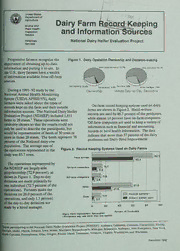
Dairy farm record keeping and information sources : National Dairy Heifer Evaluation Project PDF
Preview Dairy farm record keeping and information sources : National Dairy Heifer Evaluation Project
Historic, Archive Document Do not assume content reflects current scientific knowledge, policies, or practices. United States 1905 )s Department of Dairy Farm Record-Keeping (oy Agriculture Animal and es Plant Health and Information PREp Inspection Service Veterinary National Dairy Heifer Evaluation Project Services _ Progressive farmers recognize the Figure 1. Dairy Operation Ownership and Decision-making importance of obtaining up-to-date information and putting it to use. In Sole proprietorsnip 72.9% One individual 72.7% the U.S., dairy farmers have a wealth of information available from off-farm sources. _ During a 1991- 92 study by the Partnership 23.6% Corporation 3.5% Partners 26% Hired menager 1.3% Ownership Makes Day-to-Day Decisions National Animal Health Monitoring System (USDA:APHIS:VS), dairy farmers were asked about the types of On-farm record keeping systems used on dairy tecords kept on the farm and their outside farms are shown in Figure 2. Hand-written information sources. The National Dairy Heifer records are used by 88.3 percent of the producers, Evaluation Project (NDHEP) included 1,811 while almost 14 percent have on-farm computers. farms in 28 states.' These operations were Off-farm computers are used to keep a variety of tandomly chosen so that the results could not information such as financial and accounting y be used to describe the participants, but records or herd health information. The data would be representative of herds of 30 cows or indicate that more than 57 percent of the dairy more in those 28 states. The herds represent 78 producers use Dairy Herd Improvement percent of the National dairy cow population. The average size of the operations represented in the Figure 2. Record Keeping Systems Used on Dairy Farms study was 85.7 cows. Hand written _T he operations represented by he NDHEP are largely sole On-farm computers roprietorship (72.9 percent), as shown in Figure 1. Day-to-day Off-farm computers decisions are made primarily by one individual (72.7 percent of the DHIA> Operations). Partners make the decisions on 26.0 percent of the = Records systemises erations, and only 1.3 percent ed WE Primary System Used the day-to-day decisions are made by a hired manager. 0 20 40 60 80 100 Percent of Producers *Dairy Herd Improvement Association eeProducers may use more than one system lates participating in the National Dairy Heifer Evaluation Project (ND HEP): Alabama, California, Colorado, Connecticut, Florida, orthg iCa,a rIodlaihnoa,, PIlelninnosiysl, vaInnidiaa,n aO, hiloo,w a,O reMgaoinn,e , RMhaordyel anIdsl,a ndM,a sTseancnheussseetet,s , VMeircmhoingta,n , ViMrigninneias,o taW,a shNienbgrtaosnk,a , anNde wW isHcaomnpssihni.r e, New York, December 1992 Figure 3. Information Sources Used by Dairy Farmers to Make Health Care Decisions Veterinarian Extension/university Magazines/journals Other producers Med. supply persons Consultants ZZ Information sources* MN Primary source used Otheree i : fe) 20 40 60 80 100 120 Percent of Producers «Producers may use more than one source. *eIncludes producer associations, media, and miscellaneous sources. Association (DHIA) programs - reported here USDA’s Cooperative Extension Service and separately from other off-farm computers. Eleven university sources, and medical supply salespeople. percent use other systems of record keeping. Producers view the veterinarian as the single While a variety of record keeping systems are most important source of information (83.4 available to dairy farmers, most rely on a single percent). A few rely most heavily on information means of keeping track of the farm’s status and from the Cooperative Extension Service and dairy activities. Figure 2 shows that producers use a magazines or agricultural journals (4.0 percent ledger or notebook most often (60.4 percent) as each). ®F their primary means of record keeping. It is interesting to note that while hand-written records are an integral source of day-to-day management, a proportion of dairy farmers use some sort of NDHEP collaborators also included the National on-farm or off-farm computer, including DHIA Agricultural Statistics Service (USDA:NASS), National computing facilities as their primary method of Veterinary Services Laboratories (USDA:APHIS:VS), record keeping. This reflects the growing amount and State and Federal Veterinary Medical Officers. For of data being collected on today’s dairy farm as well more information on the National Dairy Heifer as the growing demand for information by dairy Evaluation Project and other NAHMS programs, please farmers. contact: Off-farm information sources tapped by dairy National Animal Health Monitoring System farmers to make health care decisions are shown in USDA:APHIS:VS Figure 3. As might be expected, the veterinarian is 555 South Howes, Suite 200 Fort Collins, Colorado 80521 the most common source of information. Dairy (303) 490-7800 magazines and journals are also popular, as are the W N 1022448
